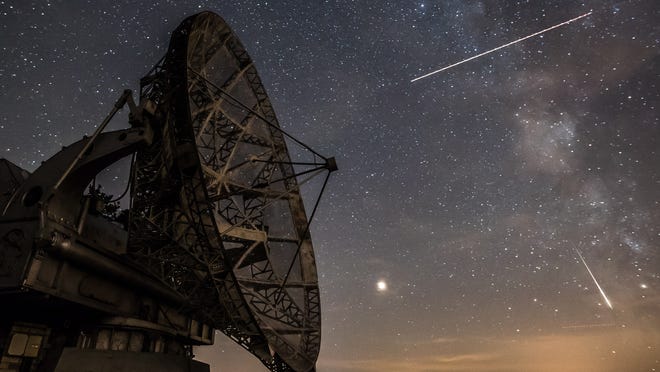- The Perseid meteor shower typically produces from 50 to 100 meteors per hour.
- The shower occurs every year when the Earth passes through the cloud of debris left by the comet Swift-Tuttle.
- No special equipment is needed to enjoy this nighttime spectacle, just a dark sky and some patience.
What NASA calls the “the best meteor shower of the year” – the Perseids – will be coming to a sky near you next week, weather permitting. The shower will peak on the night of Aug. 11-12, according to the American Meteor Society.
Unfortunately for meteor-watchers, the moon will be 100% full, which can spoil the show due to its brilliant light.
“Sadly, this year’s Perseids peak will see the worst possible circumstances for spotters,” NASA astronomer Bill Cooke, said in a statement. “Most of us in North America would normally see 50 or 60 meteors per hour, but this year, during the normal peak, the full Moon will reduce that to 10-20 per hour at best.”
The best Perseid performance in recorded history was in 1993, when the peak rate topped 300 meteors per hour, according to NASA.
Despite the full moon, what’s best about the Perseids is they can be enjoyed during summer’s warmth, unlike the often-nippy nights during the Leonids of November or Geminids of December.
SHORTEST DAY IN HISTORY:Earth completes fastest rotation ever on June 29, English lab says
What causes the Perseids?
The Perseid meteor shower occurs every year when the Earth passes through the cloud of debris left by the comet Swift-Tuttle. The meteors are actually tiny dust and particles from the tail of the comet as it orbits around the sun.
The particles, many no bigger than a grain of sand or a pea, blast across the sky at 132,000 mph and disintegrate high up in our atmosphere after making a brilliant flash of light.
Great balls of fire!
Perseids are also known for their fireballs, NASA said. “Fireballs are larger explosions of light and color that can persist longer than an average meteor streak,” the agency said.
Meteor showers are named for the constellation out of which they appear to come, according to the American Meteor Society. Look for the constellation Perseus in the northeastern portion of the sky. It’s just to the left of the Pleiades, the Seven Sisters constellation.
Who was Perseus?
In ancient Greek star lore, Perseus is the son of the god Zeus and the mortal Danae, according to EarthSky. It is said that the Perseid shower commemorates the time when Zeus visited Danae, the mother of Perseus, in a shower of gold.
No special equipment is needed to enjoy this nighttime spectacle, just a dark sky and some patience, both of which could be in short supply this year due to the full moon.


